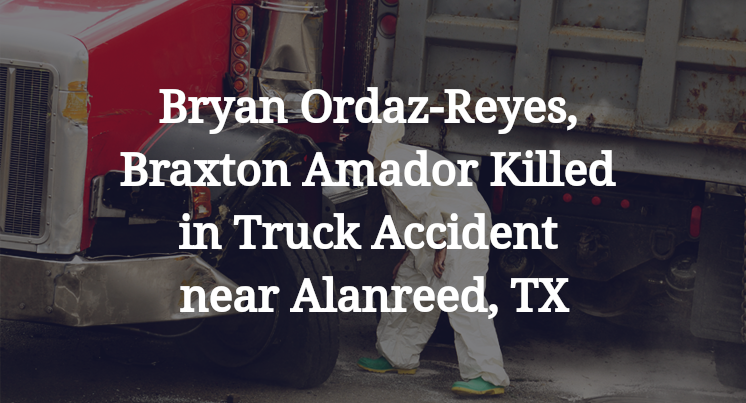Bryan Ordaz-Reyes, Braxton Amador Killed in Truck Accident near Alanreed, TX
Gray County, TX — April 26, 2025, Bryan Ordaz-Reyes and Braxton Amador were killed in a truck accident at about 2:15 a.m. on Interstate 40.
Authorities said a 2020 Freightliner semi-truck was headed east on I-40 when it crashed into a 2018 Chevrolet Camaro that was disabled in the road after an earlier accident.

Camara driver Bryan Ordaz-Reyes, 22, and passenger Braxton Amador, 19, were killed in the crash west of Alanreed, according to authorities.
Authorities have not released any additional information about the crash or the earlier one involving the Camaro, but they said severe weather likely affected visibility before the fatal collision.
The accident is still under investigation.
Commentary by Attorney Michael Grossman
When a semi-truck strikes a disabled vehicle on the interstate, especially in conditions of poor visibility, the legal questions quickly focus on whether the truck driver had a reasonable opportunity to recognize and react to the hazard in time. In this crash on I-40 near Alanreed, where two men lost their lives, it’s clear that both road conditions and driver behavior will need careful scrutiny.
According to reports, the Chevrolet Camaro was already disabled in the roadway after an earlier accident, and severe weather was affecting visibility when the Freightliner struck it. That complicates the analysis but doesn't automatically excuse the collision. Commercial drivers are trained to adjust their speed and following distance based on conditions, not just posted speed limits. In low visibility — whether from rain, fog or any other weather — drivers are expected to slow down to a speed that allows them to stop safely for hazards they might not see until the last moment.
The Freightliner’s engine control module will be an important source of evidence. It will reveal whether the truck was traveling at a speed appropriate for the conditions, and whether the driver applied brakes or made any evasive moves when the disabled vehicle came into view. Investigators should also look at dashcam footage, if available, and review weather and road reports to understand just how limited visibility was at the time.
Another critical piece of the investigation will be understanding how visible the Camaro was after its initial accident. Were its hazard lights functioning? Were there any reflective surfaces exposed? Was it sitting in a lane or on the shoulder? These details will help determine how much warning the truck driver reasonably had before impact.
Even if the Camaro was difficult to see, the responsibility placed on a commercial driver remains significant. Professional drivers are expected to anticipate that, in poor weather, stalled vehicles, debris, or other hazards could be present, and adjust accordingly. Speeding or traveling too fast for conditions in bad weather is a common contributor to these types of fatal collisions.
This crash also highlights how quickly conditions can spiral on the interstate. A single-vehicle accident may leave a car stranded, and in normal visibility, it would be a hazard but perhaps not a fatal one. Add poor weather, high speeds and the massive force of a fully loaded semi-truck, and the results are often catastrophic.
The investigation needs to fully explore not just whether the truck driver could have avoided the crash, but whether the collision was the inevitable result of decisions made, or not made, long before impact. Because when two young people lose their lives in a crash like this, it demands more than just an explanation. It demands a full accounting of every opportunity that might have existed to prevent it.

“These are essential reads for anyone dealing with the aftermath of a truck wreck”– Attorney Cory Carlson